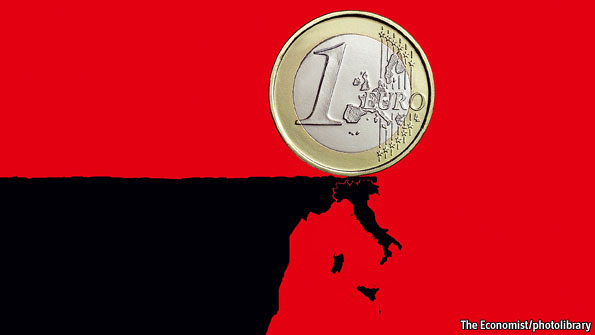– Moody’s downgrades Italian banks, outlook negative (Reuters, May 15, 2012):
Moody’s Investors Service downgraded the long-term debt and deposit ratings for 26 Italian banks on Monday, citing the country’s recession and rising bad debt levels.
The banks were all downgraded by at least one notch, and for some, by as many as four notches, Moody’s said, adding all of the banks affected have a negative outlook.
The moves marked another blow for Italy’s top five banks after they were asked to find some 15 billion euros by June to meet tougher capital requirements set by the European Banking Authority due to vast holdings of domestic government bonds.
Economic recession in Italy has worsened credit quality as banks come under pressure from the government to put cheap funding from the European Central Bank to work in the real economy.
“The ratings for Italian banks are now amongst the lowest within advanced European countries, reflecting these banks’ susceptibility to the adverse operating environments in Italy and Europe,” Moody’s said in a statement.
The ratings agency cited a return of Italy’s economy to recession, government austerity measures that are hurting demand, rising problem loans and restricted access to market funding as among the factors behind its downgrades.
The ratings agency said on April 13 that it would begin issuing conclusions to the various banking reviews currently under way for 114 European financial institutions, including Italian banks. This process was to begin in mid-May and conclude by the end of June. This represented an extension of an earlier deadline for the rating reviews.
Unicredit (CRDI.MI) and Intesa Sanpaolo (ISP.MI) – Italy’s two biggest banks – were both given deposit ratings of A3 and a standalone bank financial strength rating of C-. Unicredit’s credit assessment was baa2 while that of Intesa Sanpaolo was baa1.
Unione di Banche Italiane (UBI.MI), Italy’s fifth-largest bank, was given deposit ratings of Baa2 and a standalone bank financial strength rating of D+, while it got baa3 rating for its baseline credit assessment.
The fourth largest Banco Popolare (BAPO.MI) got a Baa3 for deposits, D-plus for standalone bank financial strength and ba1 for its baseline credit assessment. This bank faces weak capital levels, insufficient internal capital generation and funding constraints, Moody’s said.
Banca Monte Dei Paschi (BMPS.MI), the third largest bank, got a Baa3 rating for deposits, D for standalone bank financial strength and ba2 for its baseline credit assessment. “This bank faces more substantial challenges due to asset quality, capital and funding issues,” the rating agency said.
Italian banks scooped up 116 billion euros from the ECB’s long-term refinancing operation in December and another 139 billion euros from the one in February. Those funds helped them cope with frozen wholesale funding markets and a crippled interbank market at a time when the country has hovered close to the sharp end of the euro zone debt crisis.
For Italian banks, loading up on government debt purchases was partly the result of moral suasion by Prime Minister Mario Monti, who has encouraged lenders to buy domestic bonds.
Yet the banks’ increased exposure to sovereign debt is making investors jittery as bond yields are back on the rise on fears Spain’s deficit woes could spread to Italy.
The sheer scale of Italy’s outstanding 1.9 trillion euros public debt makes the whole challenge that much harder for its banks.
